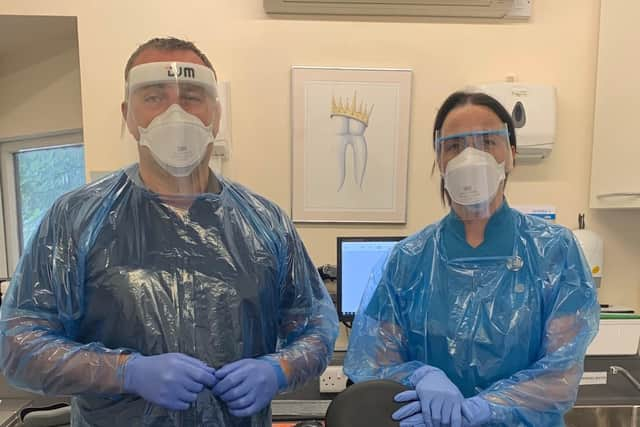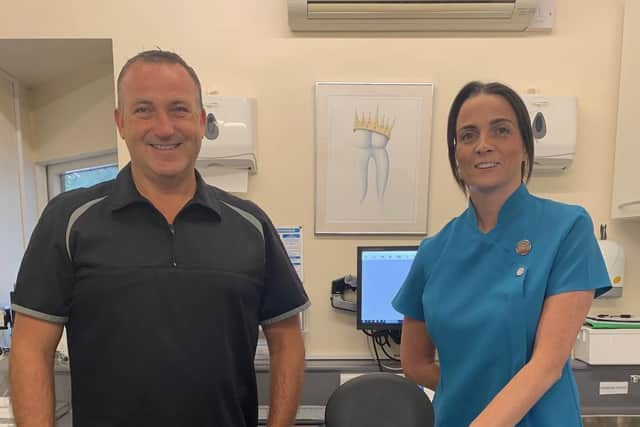Dentists back to 'new normal' but fear months of lockdown could have left Doncaster residents' teeth worse than ever
and live on Freeview channel 276
Practices across the borough closed on March 23 when the Government put the country into lockdown – and dentists say they are now starting to get back to normal after clearing a backlog of emergency cases since they were allowed to re-open in June.
But Doncaster dentist and secretary of Doncaster and Bassetlaw Local Dental Committee, John Gatus, admits there are concerns over how the crisis will have impacted on teeth in a borough already known to have dental problems.
Advertisement
Hide AdAdvertisement
Hide AdA report in 2018 warned Doncaster had some of the poorest rates of oral hygiene in the country, with 3.5 per cent of all five to nine-year-olds having had at least one tooth removed due to severe decay. The national average is 0.7 per cent. The Doncaster Oral Health Assessment Report said children and adults in the borough experience some of the 'poorest oral health in the country’.


Mr Gatus said he thought dentists in the borough were ahead of the game in getting back to a ‘new normal’ but may have much to deal with.
He said: “We are still here to look after our patients.
“We feel we’re getting back on our feet.
"But we have seen cases that would have been straight forward several months ago, where teeth would have been savable, if they had been treated early on, where teeth have had to be taken out.


“Doncaster has always been an area with high dental needs and Covid is likely to have made this much worse – but we’re all working hard to reverse this trend.”
Advertisement
Hide AdAdvertisement
Hide AdMr Gatus, who also works as a dentist in Mexborough and is clinical director for Robinson’s in Bentley, says because Doncaster has a bad record on dental health, dentists are well placed to deal with problems that arise now because of their previous experience.
Things look very different for patients in the surgery in Mexborough, and it is the same in dentists across the borough.
Right from the clear screen which separates the reception area from visitors when they arrive, safety measures are in place to stop the spread of the coronavirus.
In the treatment room itself, for many patients, the dentist will look very different too.
Advertisement
Hide AdAdvertisement
Hide AdFor some treatments, which produce a lot of spray, all the clinical staff in the room who are looking after the patient will have to step into full personal protective equipment.
For Mr Gatus and his dental assistant, that means a face mask, and a full, clear visor on the head. A long plastic overall covers the body right down to knee level. Blue plastic gloves are worn over the hands. They look little different to the NHS staff working on the critical care Covid wards.
But this is the current normal.
After practices were told to close on March 23, South Yorkshire Local Dental Committees worked with Public Health England to set up ‘emergency’ hubs to treat emergencies, such as spreading infection and pain that could not be controlled by pain killers.
Most were open in late April for limited treatments.
General practice dentists were finally allowed to re-open on June 8.
Advertisement
Hide AdAdvertisement
Hide AdBut things are now very different. Dentists wear the most protective equipment for treatments that create tiny droplets, known as ‘aerosol’
To use this protective equipment they have to pass a test to make sure it is safe.
Also they have to leave the treatment room empty for 60 minutes after working on a patient before they are allowed to disinfect it.
It means fewer patients can be seen than pre-Covid.
It meant initially, only emergency, priority treatments were carried out. But more general check-ups are now finally being done.
Advertisement
Hide AdAdvertisement
Hide AdMr Gatus said of the re-opening in June: “We’ve been playing catch up since then with a prioritised system.
“It’s important for patients to realise that all local practices should now be open providing some level of face to face care. It’s a new normal with new procedures and protocols to ensure safety for patients and the dental team. Teeth are an important part of general health and shouldn’t be neglected, so patients with any concerns should contact their dentist for advice and treatment as needed.”
He felt the main issues during the coronavirus period had been practice closures and access problems, PPE shortage and limitations to treatments, and frequently changing guidance.
The emergency hubs are still formally open, but referrals to them have now stopped because of the return of the normal dental practices.
Advertisement
Hide AdAdvertisement
Hide AdFor Mr Gatus and his team, the work is now often done using more old fashioned tools. Electric scalers, for polishing teeth for instance, are now often replaced by manual ones. They are slower but produce less droplets.
He feels they are getting back to a sort of new normal, but does not expect things to return to what would have previously considered normal for some time.
The Government measures the coronavirus risk on a scale of one to five. The current level, level three, means the virus is in general circulation and social distancing is relaxed. The next level, if things improve, would be level two, which would mean the number of cases and transmission was low and minimal social distancing was needed.
Mr Gatus said: "Realistically, we’re not going to be back to normal until we get to level two in the Government’s rating system, and I think it’s going to be level three for some time. Personally I don’t think we will be back to normal until the middle of next year.”